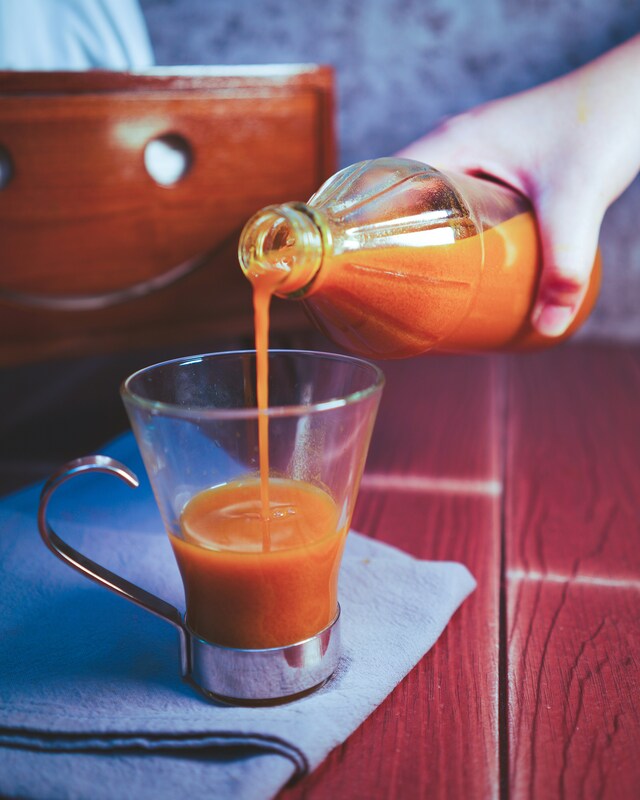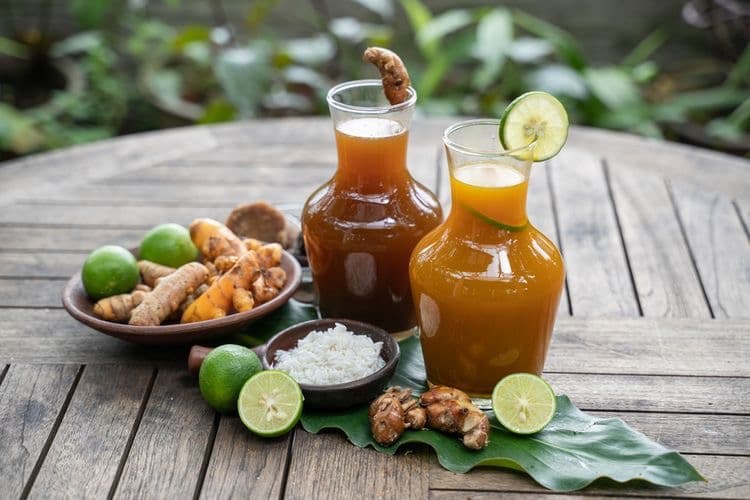What was once an ancient herbal tradition, lovingly prepared by jamu gendong women in Indonesia’s villages, is now making its mark on the global wellness scene.
What was once an ancient herbal tradition, lovingly prepared by jamu gendong women in Indonesia’s villages, is now making its mark on the global wellness scene.
For centuries, jamu has been woven into the daily lives of Indonesians, an earthy elixir handed down through generations, a testament to both nature’s healing power and cultural pride. Jamu’s natural potency, drawn from earthy blends of roots, spices, and medicinal plants, is no longer confined to local markets or family kitchens. Instead, it’s finding a home in vegan cafés, Instagram-ready smoothie bowls, and even high-end skincare, all pointing towards jamu’s rebirth.
Yet, this trend is more than just turmeric shots and health claims. It’s a microcosm of cultural exchange: a centuries-old tradition rebranded for modern tastes. But as jamu rides the wave of global fascination, questions arise: Who truly owns these ancient elixirs? Is it a cultural celebration or clever co-opting?
The Roots
Jamu isn’t new, it’s a living tradition that dates back to the Mataram Kingdom in 9th-century Java, where healers crafted herbal blends for the royal family’s health. Over time, these remedies trickled down to everyday communities, becoming an integral part of Indonesian daily life.
Jamu is a traditional Indonesian herbal concoction crafted from an assortment of natural ingredients, including roots, barks, leaves, seeds, and medicinal plants. These age-old elixirs are deeply woven into the country’s cultural heritage, passed down through generations as both preventative tonics and therapeutic remedies. Beyond its role as a daily health booster, jamu is also believed to enhance stamina and aid in the treatment of various ailments.
Indonesia’s jamu tradition offers a rich variety of herbal blends, each with its own purpose and unique ingredients. Among the most popular is kunyit asam, made from turmeric and tamarind, renowned for its digestive benefits and women’s health support. Beras kencur, combining rice and aromatic ginger, is cherished for easing fatigue and boosting energy. Temulawak, with its earthy Javanese ginger, is believed to fortify the liver and enhance immunity. There’s also tolak angin, a modern jamu derivative made from a blend of herbs to relieve colds, congestion, and body aches. For those seeking stronger medicine, pahitan (a bitter concoction featuring brotowali) has long been trusted to support liver health and strengthen the body’s defences.
At the heart of jamu’s story are the jamu gendong women, iconic figures carrying bamboo baskets brimming with glass bottles filled with earthy potions. National Geographic once featured them as symbols of Indonesia’s intangible cultural heritage, their craft blending nature, community, and healing in a single sip.
Jamu isn’t just a drink, it’s a philosophy. One that celebrates the synergy of local plants and traditional wisdom.
The Reinvention
From its humble beginnings at roadside warungs all the way to trendy wellness cafés and luxury spas, jamu has found new life in modern Indonesia and beyond. As global health enthusiasts flock to Bali and Jakarta in search of natural elixirs, jamu’s ancient roots have been reimagined in ways that both honour and challenge tradition.
- Drinkable Jamu
Globally, jamu’s reinvention is everywhere. Starbucks’ turmeric latte, for instance, borrows from jamu’s kunyit asam—turmeric’s earthy warmth mixed with the tang of tamarind—rebranded as a hip, golden-hued beverage. Closer to jamu’s homeland, the Night Rooster bar in Bali has embraced the herbal drink with a twist by serving creative jamu-based cocktails (the Mbok Jendul or Kakap, if you’re curious to try).
Innovative brands are redefining jamu’s preparation and presentation. Acaraki, a modern jamu café, exemplifies this by employing coffee brewing techniques such as V60 pour-over, French press, and espresso machines to craft their herbal drinks. Their menu includes offerings like “Golden Sparkling,” a fizzy turmeric-based beverage that merges traditional flavours with contemporary tastes. By integrating these methods, Acaraki not only modernises jamu but also makes it more accessible to younger generations and international audiences.
Similarly, Re.juve introduces cold-pressed jamu beverages, blending traditional ingredients with modern juicing techniques to preserve nutritional value and flavour. These innovations reflect a broader movement to adapt jamu to contemporary lifestyles while honouring its rich heritage.
- Beauty & Skincare
Jamu’s revival doesn’t stop at drinks. Brands like JUARA Skincare exemplify this fusion, drawing inspiration from Indonesia’s jamu tradition to create products that nourish both skin and spirit. Their offerings, such as the Clove Flower & Turmeric Anti-Ageing Serum and the Triple Tea Antioxidant Essence, harness the power of traditional ingredients like turmeric and tamarind to promote radiant, healthy skin.
DJAMUJAMU is another brand bringing this holistic approach to modern skincare. Their range of facial serums and creams, infused with botanical extracts, transforms jamu’s philosophy into daily rituals. Products like the Anti-Ageing Serum Concentrate and Clarifying Face Mask integrate herbs such as turmeric and kencur to detoxify, brighten, and nurture the skin.
Both brands underscore jamu’s adaptability: what was once a humble herbal remedy has evolved into a luxurious, globally sought-after wellness ritual.
- Controversial Twists
Not all modern jamu experiments sit comfortably with tradition. In some wellness clinics in Bali, for example, jamu is being transformed into intravenous (IV) drips, touted as “liquid wellness” solutions for boosting energy and detoxifying the body. However, medical professionals question the safety of injecting herbal ingredients directly into the bloodstream, a method that bypasses traditional jamu preparation and consumption rooted in centuries-old practice.
In jamu’s case, its transformation from home-brewed herbal remedies to trendy wellness shots and even alcoholic infusions in Bali bars can be seen as a double-edged sword. On one hand, it sparks new interest in an ancient tradition; on the other, it risks diluting the holistic, ritualistic essence of jamu.
Beyond these modern interpretations, scientific research is catching up with jamu’s traditional wisdom. A 2023 study published on PubMed highlighted the potent anti-inflammatory properties of curcumin, turmeric’s active compound, lending scientific weight to jamu’s centuries-old claims of boosting immunity and reducing joint pain.
The Ethics
In Indonesia, jamu has long been a living tradition passed down informally. Its recipes, rituals, and medicinal uses, embedded in family knowledge. But as jamu’s popularity grows, there is increasing concern that the movement is evolving in ways that prioritise commercial gain over cultural preservation.
There is a stark economic disparity in how jamu is marketed and consumed. In traditional neighbourhoods, jamu gendong vendors (often women) continue to sell herbal drinks for as little as Rp10,000, sustaining livelihoods in the informal sector. By contrast, jamu-based wellness treatments in luxury spas or cafes can cost up to 25 times more, raising questions about who benefits from this modern jamu revival.
This price disparity underscores the risk of cultural gentrification, where jamu’s symbolic and economic value is extracted and repackaged for high-end consumption while the original stewards of the tradition are left on the margins.
Moreover, as the world’s thirst for wellness deepens, it’s unclear whether small farmers and jamu gendong vendors can keep pace with the escalating demand for key ingredients like temulawak, kunyit, and kencur. This raises important concerns about how to protect the livelihoods and resources that have sustained these traditions for generations.
However, it’s also important to note that some modern jamu initiatives seek to bridge this gap by engaging directly with jamu communities. These efforts show that ethical revitalisation is possible when businesses respect and include traditional knowledge holders, reinvest in local economies and preserve the nuanced cultural meaning of jamu.

Trend or Timeless?
Since 2020, Google searches for “jamu” have surged by 300%, signalling that this once-local remedy has stepped firmly into the global spotlight. Much of this renewed interest can be credited to the early days of the pandemic in Indonesia when jamu was touted as a natural immune booster and remedy to fight COVID-19. Lockdowns and health anxieties pushed many Indonesians to return to these ancient brews, sparking a new wave of curiosity both at home and abroad. What started as a grassroots revival has now transformed jamu into an international wellness trend.
This trend speaks to a broader phenomenon: the collision between cultural authenticity and commercial innovation. Scholars of cultural heritage argue that while cultural practices inevitably evolve, this evolution must remain anchored in respect for their original social and spiritual meanings.
Ultimately, jamu’s transformation in the global marketplace spotlights a broader dilemma: how to nurture innovation and expansion without eroding the social and spiritual significance that makes jamu more than just a drink or beauty product. The answers lie not just in commercial practices, but in recognising jamu as a cultural legacy that deserves both celebration and protection.
So, as jamu continues its global renaissance, perhaps the real lesson is this: drink it, debate it—but above all, honour it. Learn the histories behind every golden-hued cup, and remember that the best traditions aren’t static relics. They’re living stories, sustained by those who hold them close.




